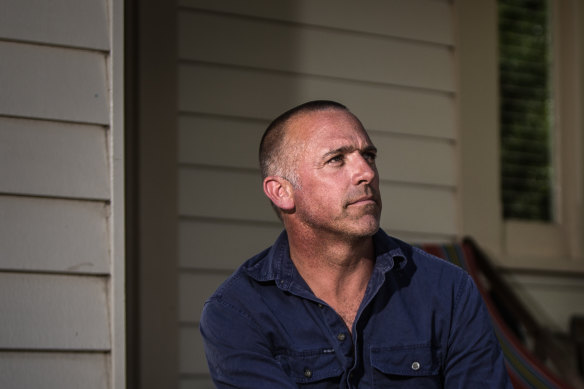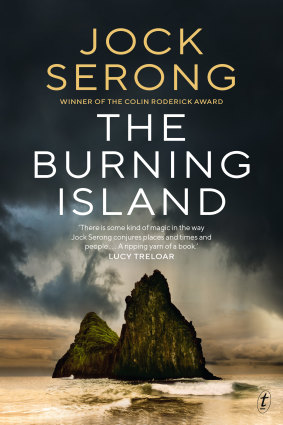This was published 4 years ago
A dramatic voyage into the choppy waters of colonisation
By Declan Fry
FICTION
The Burning Island
Jock Serong
Text, $32.99
Jock Serong's fifth novel is a sequel-of-sorts to his previous offering, Preservation. There, Serong reimagined the wrecking of the Sydney Cove in 1797; here, the narrative is based on another real-life shipwreck: the Britomart, which foundered in 1839 off Preservation Island in lutruwita (Tasmania).

Jock Serong interrogates the history of colonisation in The Burning Island.Credit: Christine Ansorge
Our heroine is Eliza Grayling, the daughter of Preservation's protagonist Joshua Grayling. Thirty-two years old and unmarried, she accompanies her father to locate the wreck of the Britomart (here the Howrah). Suspecting the vessel has been destroyed by Preservation's villain, the nefarious Figge, they set off to discover the truth. Joining them on their voyage is the shipmaster, Argyle, a crew of two young convict brothers and Dr Gideon, an amateur naturalist.
Their journey leads them to the fringes of the growing New South Wales colony – a world in which sealers operated across the Furneaux Group, concealing the tyereelore women they kept as wives (and who were abducted, or consensually given over for marriage by clansmen, in north-eastern lutruwita) from the agents of George Augustus Robinson, the emissary of Governor George Arthur responsible for rounding up hundreds of Aboriginal men, women, and children into internment camps.
As in Preservation, Serong's period voice is assured, moving artfully out of sight in the narrative wings. The dialogue occasionally sees the author peeking from behind the curtains, though; it performs a lot of heavy lifting. Sentences strain for a gravitas that, spotlit between quotation marks, can feel bathetic.
When Argyle speaks to Eliza about bearing the loss of a loved one, he sounds less like a character and more like Serong's authorial voice: "You must be feeling all these things, and choosing among them. You decide. You are fated to carry this all your days now, this loss. But you may alter its shape; that is the once grace permitted you."

Credit:
Serong's evocation of consciousness is more successful when told through that consciousness – as when Eliza, in a finely wrought passage concerning her ageing father, reflects: "People diminish, in a real sense, with age. But perhaps it was the waning of my childhood admiration that made him small now."
Training a contemporary consciousness on events of the past, Serong interrogates the history of colonisation. Preservation Island's community is depicted as an embattled refuge from the demands of religious evangelists and voracious government paternalism (a portrayal that, recalling Preservation's nods to Bruce Pascoe and Bill Gammage, feels tangibly influenced by the work of Patsy Cameron).
Serong provides a compelling portrait of Tarenorerer, a real-life warrior of the Tommeginne people in Emu Bay, who fought bravely against abduction, captivity and slavery. Asked by Joshua Grayling whether she is a sealer's wife, her attitude to European invasion may be gleaned from her response: "I'm nobody's wife, luta tawin! This body, only thing I own, and I'll be usin it for makin mayhem."
Indeed, fighting colonisation is not Tarenorerer's only skill: under the accumulating weight of incidents that do not always seem essential to the story, the middle section of the novel idles (an issue that also troubled Preservation); the introduction of Tarenorerer helps to revive its atrophying narrative momentum.
The novel's depictions of gender and sexual relations are informed by a similarly contemporary sensibility. Eliza has a sexual and psychological power that The Burning Island's social-realist templates, produced nearly a century before the advent of second-wave feminism, could only have implied (particularly when those exemplars were authored by men).
Like many 19th-century couplings, Gideon and Eliza engage in a sexual pas de deux – one that initially thrives on inhibition and suggestion, but becomes increasingly uneasy as it threatens Eliza's sense of control over events. The frisson of their meetings recalls Darcy and Elizabeth in Pride and Prejudice, with all the tastefully excised sex scenes brought back (again, tastefully).
Serong has written a fine historical novel in The Burning Island. Its vivid depiction of Tasmania's frontier wars during the 19th century, and those who survived them, allow us to reconsider the colonial infancy of the burning island we inhabit today.

Credit:

Credit: